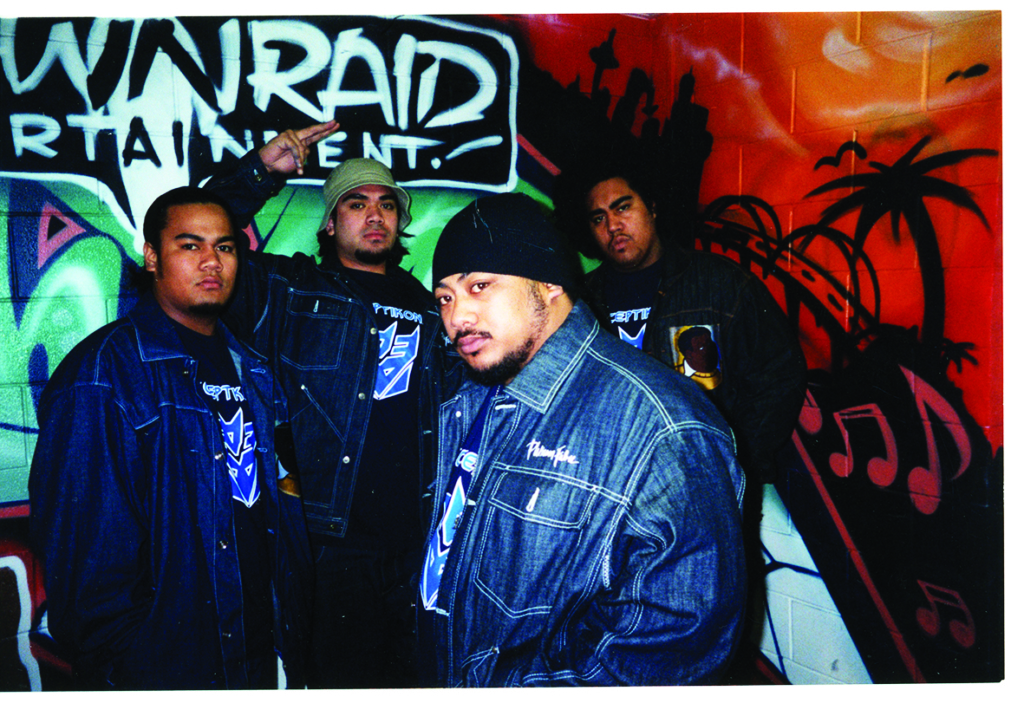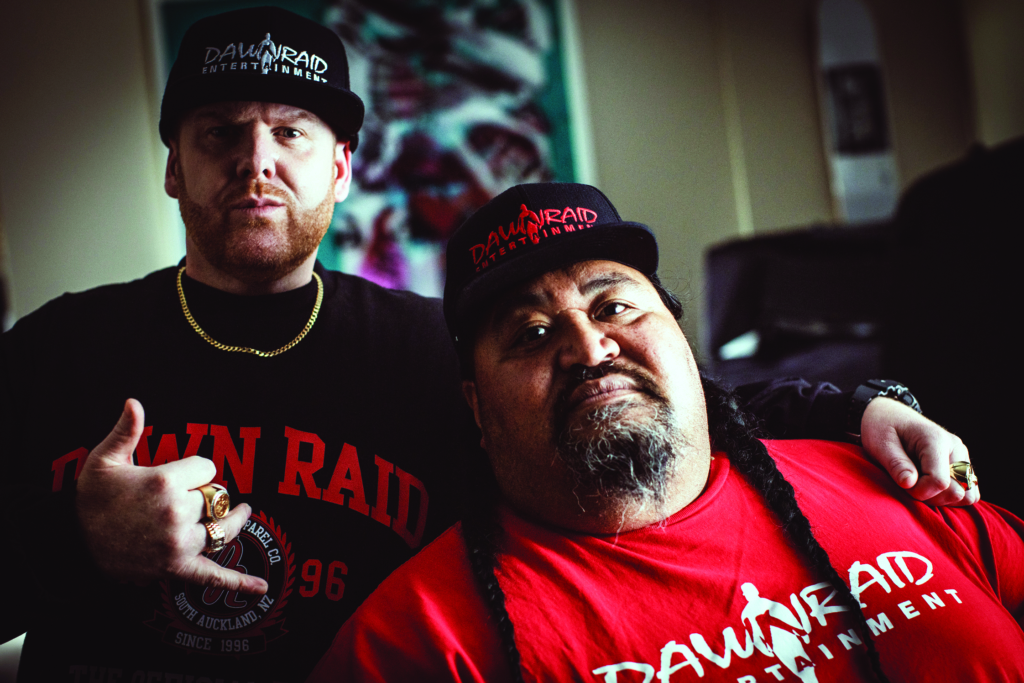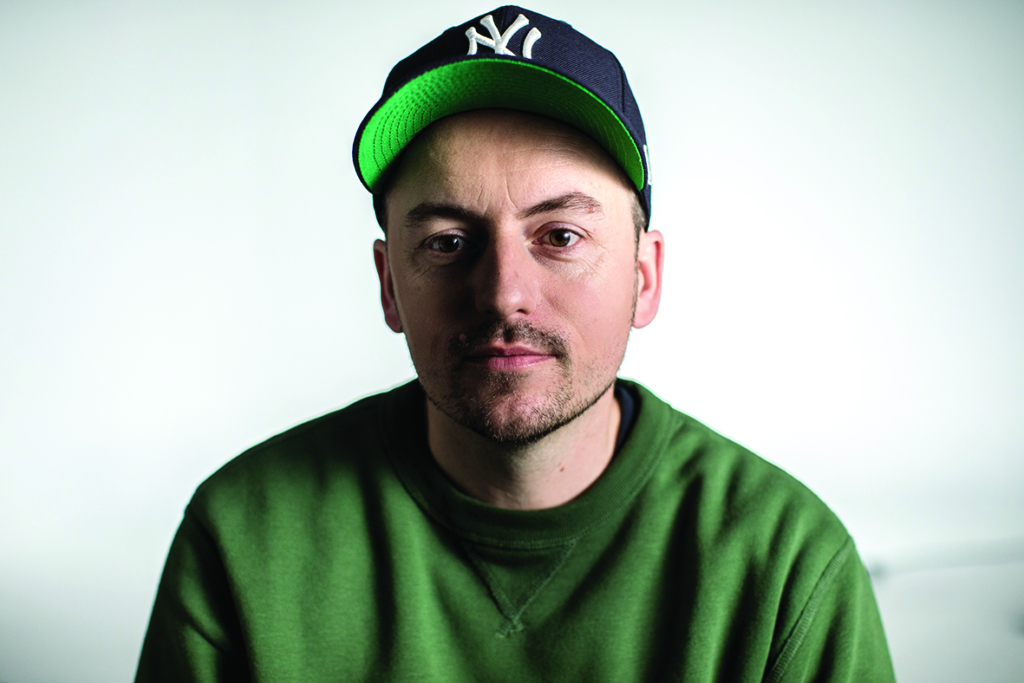The first words we hear in Dawn Raid (2021),Oscar Kightley’s enormously entertaining feature-length documentary about the rise, fall and rebirth of Dawn Raid Entertainment – New Zealand’s first and, by far, most influential hip-hop label – are American. ‘Yo, yo, yo,’ says an identifiably African-American voice on an answering machine, as we see images of the Manhattan skyline glistening in glorious early-morning sunlight. ‘What’s up, Dawn Raid? Hey, let’s make this worldwide global money on this rap shit.’
Over the next hour and thirty-eight minutes, we will see Dawn Raid Entertainment indeed make some global money out of rap music, including in New York City – and go on to lose some substantial money, too. Their story, and this movie, is a cautionary business tale about how two young fellas with big dreams met at a marketing class at the Manukau Institute of Technology, created an industry and almost lost it. But it is also, if never explicitly, about the fundamental cultural contradictions at the heart of ‘global’ rap and hip-hop. From day one of the company’s formation in 1999, the founders of Dawn Raid Entertainment had their sights on the US market, and fashioned their corporate, musical and personal identities on US models. In the end, however, they created something culturally unique, based not on the US hip-hop market’s traditional themes of gang violence, misogyny, homophobia and feuds, but on the highly specific cultural identity of New Zealand Polynesians, particularly in the locality of South Auckland.
Rap and hip-hop music evolved organically in the United States; everywhere else it occurred as emulation (and imitation) through appreciation, appropriation and identification. As New Zealand rapper P-Money says, in the film, of the 1990s, ‘We’re constantly bombarded with what is imported from the US; that’s what’s marketed to us all the time,’ as we see images from various 1990s American hip-hop music videos with the full panoply of tropes on display: excessive bling, gold-capped teeth, pimp suits and hats, scenes in the club, and single men in all of the above surrounded by ludicrously sexualised women. But the very next words we hear are from Dawn Raid co-founder Danny ‘Brotha D’ Leaosavai’i: ‘We had the American stuff on radio, but … we were Polynesians.’ The images shift from the fantastically gaudy wealth porn of the US videos to grainy, boxy VHS footage of urban Polynesian children. ‘We’re kids from South Auckland. We had our own voice.’
Footage continues of South Auckland – of barbed-wire fences, factories, run-down houses and businesses, crime-scene tape, and other images of urban degradation – as the other co-founder of Dawn Raid Entertainment, Andy Murnane, says, ‘When people hear South Auckland, they think Polynesian Maori, the ghetto, crime; people think it’s the scariest place in New Zealand. They think nothing good comes from there.’

Murnane, who is white, co-narrates the story of his label with Leaosavai’i, who is Polynesian, and the story they tell consistently references the American hip-hop scene as both inspiration and goal. Murnane, who gets more screen time than his partner – they are filmed at different times in different locations – comes across in particular as being (healthily) obsessed with the US hip-hop market, with the signifiers of Black American hip-hop culture and with money. ‘I thought, “millionaire” – what a wonderful word,’ he says at one point, describing his teenage goals. ‘And I got this thing in my head, like, “I’ll be a millionaire by the time I’m twenty-one.”’ He is clearly thrilled as he reels off the names of touring Black American hip-hop heavyweights he got to meet once Dawn Raid artists became their go-to New Zealand opening acts. And, recounting Dawn Raid Entertainment’s glorious heights, he says, ‘We were living the dream. We were in New York. And we had sold a million records […] Everything I ever dreamed of … whoa! We’re here.’ Yet Dawn Raid works most intriguingly – and joyously – as a portrait of a culture far removed from the detritus and degradations of much of the American gangsta-rap scene. This is a hip-hop movie with no guns nor gangsters, and the only drug on display is a reefer smoked by an American rapper.
It comes at an interesting time. Global discussions on race and culture never stop, but 2020 was clearly a watershed. The protests, first in the US, then across the world, in the wake of the murder of George Floyd by police officers in Minneapolis in May[1]See Evan Hill et al., ‘How George Floyd Was Killed in Police Custody’, The New York Times, updated 23 February 2021, <https://www.nytimes.com/2020/05/31/us/george-floyd-investigation.html>, accessed 4 March 2021. gave voice to a second wave of the Black Lives Matter movement, taking it truly international[2]For further discussion of this, see Steven Aoun, ‘Bearing Witness: Black Lives Matter Protests as Media, and Mediated, Event’, Metro, no. 207, 2021, pp. 102–6. – and, in the process, recontextualising the global understanding of ‘Blackness’. In mid June, hundreds of newsrooms across the United States began capitalising the ‘B’ in ‘Black’; and, since then, others around the world have followed suit.[3]See Elahe Izadi, ‘Why Hundreds of American Newsrooms Have Started Capitalizing the “B” in “Black”’, The Washington Post, 19 June 2020, <https://www.washingtonpost.com/lifestyle/media/why-hundreds-of-american-newsrooms-have-started-capitalizing-the-b-in-black/2020/06/18/7687a7a8-b16e-11ea-8f56-63f38c990077_story.html>, accessed 3 February 2021. Prompted by the protests, they were responding to a case put forward most prominently in an essay in The New York Times in 2014 by Lori L Tharps, who wrote, ‘Black with a capital B refers to people of the African diaspora. Lowercase black is simply a color.’[4]Lori L Tharps, ‘The Case for Black with a Capital B’, The New York Times,18 November 2014,<https://www.nytimes.com/2014/11/19/opinion/the-case-for-black-with-a-capital-b.html>, accessed 3 February 2021.
The particular New Zealand Polynesian community Dawn Raid Entertainment was speaking for, through its very name, was drawn from those immigrant families who were targeted in ‘dawn raids’ in the 1970s by the government and police for expulsion.[5]See Jamie Tahana, ‘Dawn Raids Remembered in Exhibit 40 Years On’, RNZ, 19 July 2019, <https://www.rnz.co.nz/international/pacific-news/394780/dawn-raids-remembered-in-exhibit-40-years-on>, accessed 4 March 2021. As Leaosavai’i says, ‘Our people came here because New Zealand needed cheap labour. Then when the economy started ticking over, we were the first ones they wanted to get rid of.’ There is reverberation with Tharps, who wrote in a blog post that was the precursor to her New York Times essay,
Black with a capital ‘B’ refers to a group of people whose ancestors were born in Africa, were brought to the United States against their will, spilled their blood, sweat and tears to build this nation into a world power and along the way managed to create glorious works of art, passionate music, scientific discoveries, a marvelous cuisine, and untold literary masterpieces.[6]Lori L Tharps, ‘I Refuse to Remain in the Lower Case’, My American Meltingpot, 2 June 2014, <https://myamericanmeltingpot.com/2014/06/02/i-refuse-to-remain-in-the-lower-case/>, accessed 9 February 2021.
In online discussion, ‘brown’ – which remains uncapitalised in most publications globally – seems to be the preferred term for Polynesians in New Zealand when referring to the colour of their skin, but many young Polynesians identify with American ‘Blackness’ for multiple reasons,[7]See Reddit discussion thread ‘Why Do Some Polynesians Consider Themselves Black?’,<https://www.reddit.com/r/AskAnthropology/comments/at0olv/why_do_some_polynesians_consider_themselves_black/>, accessed 17 March 2021. including the Black Power movement of the 1960s and 1970s,[8]See Mohammed Elnaiem, ‘On Black Power in the Pacific’, JSTOR Daily,20 August 2020, <https://daily.jstor.org/on-black-power-in-the-pacific/>, accessed 3 February 2021. the current Black Lives Matter movement, and, not insubstantially, American hip-hop and rap. There is identification with the struggle – if not, precisely, the skin.
‘Brown’ is used by Murnane in the film to identify Polynesian skin colour. Talking of his collaboration with Leaosavai’i, Murnane says, ‘Because I was white, and he was brown, it was like, oh, we’re challenging the system.’ Later, referring to their first meeting in that marketing class, Murnane refers to Leaosavai’i as a ‘big, friendly Island guy’. ‘Polynesian’, ‘brown’, ‘Island’ and ‘South Auckland’ are the primary identifiers throughout Dawn Raid, and ‘Blackness’ is not. Indeed, in keeping with the good-natured tone of the film, the contradiction between Polynesian brownness and American urban Blackness is highlighted when Samoan New Zealander Dawn Raid artist Mareko is taken to New York: amid a montage of ‘fish out of water’ footage – the rapper is stunned by the scope of the New York City Subway map, the lights of Times Square, the traffic – he is ultimately shown standing in the Harlem snow in his open-toed sandals, smiling sheepishly, as Murnane says in voiceover, ‘He didn’t stop being a South Auckland kid in Harlem.’

While a subtle but clear distinction is thus being drawn between New Zealand brownness and American Blackness, Murnane is unafraid to appropriate other American urban terminology wholeheartedly, specifically referring to South Auckland, multiple times, as ‘the hood’. Whether or not many other inhabitants of South Auckland would see their neighbourhood that way, ‘the hood’, as Murnane uses it, is evocative of a specifically Black American space; as Henry Grabar wrote in Bloomberg CityLab in 2012,
Helped along in the popular imagination by countless gangsta rap verses and movies […] ‘the hood’ came to define inner-city black neighborhoods from the South Bronx to Compton […] And though ‘hood’ seems like so obvious a shortening of neighborhood that there’s no point arguing over its provenance, nobody ever used it as such until a black Chicago gang – the Blackstone Rangers – did so in the 1960s.[9]Henry Grabar, ‘Nabe or Hood? A Brief History of Shortening “Neighborhood”’, Bloomberg CityLab, 27 August 2012,<https://www.bloomberg.com/news/articles/2012-08-27/nabe-or-hood-a-brief-history-of-shortening-neighborhood>, accessed 3 February 2021.
Murnane addresses this appropriation, saying, ‘The hood is the hood; hoods are the same, everywhere in the world. The ghetto is the same; poverty is the same.’ South Auckland, in the film, is certainly presented as economically challenged, underprivileged, hardscrabble. Murnane’s use of ‘the hood’ specifically evokes the urban ghettos of Boyz n the Hood (John Singleton, 1991), 8 Mile (Curtis Hanson, 2002) and countless other films set in Black American neighbourhoods; but, once again, a point of distinction is the lack of guns and any mention of hardcore violence.
Much as Murnane and Leaosavai’i relentlessly pursued their fortunes in urban Black communities in the US, they ultimately found their greatest success there among the demographically dominant, gigantic white American suburban audience.
What the movie does reference is theft. Once the Dawn Raid studio was established in South Auckland, as Leaosavai’i says, ‘with all the great positive, [came] the negative as well’. The studio was burglarised six times, and the police were not of any great help; but the incidents, while clearly frustrating to Leaosavai’i and Murnane, are related by them with laughter and fondness. Murnane is smiling broadly when he says, ‘It’s the hood, man, we so hot in the streets they’re gonna steal our stuff!’ Leaosavai’i is smiling, too, when he relates: ‘The police said, […] “It’s that stupid music you guys are making.”’ The intended inference is clear: American hip-hop is inherently criminal.
Especially in the 1990s, that inference was fair, as hip-hop plainly and consistently branded itself as criminal. There have been scores of American hip-hop documentaries, biopics and narrative features, and while the best of them celebrate the intricate artistry and rich history of this culturally organic artform, nearly all have to deal with the genre’s malodorous, ever-present dark side: crime, guns, drugs, misogyny, homophobia and violence. From Biggie and Tupac (Nick Broomfield, 2002) to 69: The Saga of Danny Hernandez (Vikram Gandhi, 2020), there is a recurrent narrative of beefs being resolved by bloodshed and criminality, and a recurrent strain of lyrics that at best glorify but far too often objectify – and far worse – women and womankind. More than jazz, more than movie musicals, more than breakfast television, hip-hop is an American artform, and modern America has – and certainly had in the 1990s – a spectacular gun problem, along with rates of murder, violence and general criminality unheard of in New Zealand. Writing in 2019, Scientific American blogger John Horgan noted, ‘The rate of gun-related homicide in the [US] is 29.7 for every million people, compared to 1.6 per million in New Zealand (before the Christchurch massacre).’[10]John Horgan, ‘New Zealand Acts to Reduce Mass Shootings. Why Won’t the U.S.?’, Scientific American, 1 April 2019, <https://blogs.scientificamerican.com/cross-check/new-zealand-acts-to-reduce-mass-shootings-why-wont-the-u-s/>, accessed 8 February 2021.
Hip-hop in the US in the 1990s was an incredibly rich, bold, fresh, provocative, intricate, thrilling artform – wideranging in its scope – but it is unquestionable that rap lyrics tended to focus on violence, criminality, murder and guns. Writing on the changing imagery in rap lyrics from the 1970s to the 1990s, behavioural-science researcher Denise Herd found that ‘the percentage of songs mentioning violence increased from 27 per cent during 1979–1984 to 60 per cent during 1994–1997’, and that ‘portrayals of violence in later songs are viewed in a more positive light as shown by their increased association with glamor, wealth, masculinity, and personal prowess’.[11]Denise Herd, ‘Changing Images of Violence in Rap Music Lyrics: 1979–1997’, Journal of Public Health Policy, vol. 30, no. 4, December 2009, pp. 395–406.

New Zealand is not America, nor was it in the 1990s – and, as much as Murnane and Leaosavai’i relentlessly pursued their fortunes in urban Black communities in the US, they ultimately found their greatest success there among the demographically dominant, gigantic white American suburban audience. One Dawn Raid act, Savage, had his relentlessly cheery, hummable earworm ‘Swing’ suddenly and improbably chosen as the song being played in a suburban white club for the meet-cute between Seth Rogen and Katherine Heigl’s white characters on the dance floor in Knocked Up (Judd Apatow, 2007). That (very white) film went on to enormous success, with unexpected and astonishing results for Savage and Dawn Raid Entertainment. As Murnane describes it, ‘Seth Rogen and Judd made a cool comedy that everyone liked right at the same time that social media clicked. Timing is everything. It’s the first time this word comes out called “viral craze”.’ Over clips from multiple YouTube videos of specifically white people – predominantly women – dancing to the song, Murnane says, ‘White girls in America pick up on “Swing”. We’re thinking it’s a hardcore, in-the-hood, Black music. It wasn’t. It was a white college campus, drink, university, viral breakout.’
Dawn Raid Entertainment, as a label, aspired – desperately – to the American market and model. But what they created was ultimately far more local: New Zealand, Polynesian, South Auckland. They had some global economic, chart and internet success (ironically, particularly with white American audiences), and they launched some superb musical acts – most of whom are featured in the documentary, including Savage, Mareko, Deceptikonz, Adeaze and Aaradhna. The music is great, fusing clear US rap influence with specifically New Zealand Polynesian concerns. Leaosavai’i and Murnane have a legitimate and substantial entertainment legacy. But along the way – though this is only briefly highlighted in the film – they also created a community trust, nurturing and educating South Auckland youth. Leaosavai’i now devotes his time to community work, helping troubled Polynesian young people through Oranga Tamariki, the New Zealand Government department responsible for the wellbeing of children.[12]See ‘Dawn Raid’s Brotha D: My Wife Saved My Life’, Woman’s Day, 25 January 2021, <https://www.nowtolove.co.nz/celebrity/movies/dawn-raid-brotha-d-44892>, accessed 3 February 2021. Dawn Raid opens with images of a glittering, sun-blessed Manhattan skyline and an unmistakably Black American voice, but the voices of Dawn Raid’s artists and founders are ultimately their own – and Dawn Raid is ultimately less a hip-hop movie than a Polynesian one. Murnane and Leaosavai’i indeed made some ‘worldwide global money on this rap shit’, and impressed some Black artists; but, more importantly, they made some great Polynesian music, and contributed monumentally to their community by giving them what hip-hop has always given Black artists: opportunity.
Endnotes
| 1 | See Evan Hill et al., ‘How George Floyd Was Killed in Police Custody’, The New York Times, updated 23 February 2021, <https://www.nytimes.com/2020/05/31/us/george-floyd-investigation.html>, accessed 4 March 2021. |
|---|---|
| 2 | For further discussion of this, see Steven Aoun, ‘Bearing Witness: Black Lives Matter Protests as Media, and Mediated, Event’, Metro, no. 207, 2021, pp. 102–6. |
| 3 | See Elahe Izadi, ‘Why Hundreds of American Newsrooms Have Started Capitalizing the “B” in “Black”’, The Washington Post, 19 June 2020, <https://www.washingtonpost.com/lifestyle/media/why-hundreds-of-american-newsrooms-have-started-capitalizing-the-b-in-black/2020/06/18/7687a7a8-b16e-11ea-8f56-63f38c990077_story.html>, accessed 3 February 2021. |
| 4 | Lori L Tharps, ‘The Case for Black with a Capital B’, The New York Times,18 November 2014,<https://www.nytimes.com/2014/11/19/opinion/the-case-for-black-with-a-capital-b.html>, accessed 3 February 2021. |
| 5 | See Jamie Tahana, ‘Dawn Raids Remembered in Exhibit 40 Years On’, RNZ, 19 July 2019, <https://www.rnz.co.nz/international/pacific-news/394780/dawn-raids-remembered-in-exhibit-40-years-on>, accessed 4 March 2021. |
| 6 | Lori L Tharps, ‘I Refuse to Remain in the Lower Case’, My American Meltingpot, 2 June 2014, <https://myamericanmeltingpot.com/2014/06/02/i-refuse-to-remain-in-the-lower-case/>, accessed 9 February 2021. |
| 7 | See Reddit discussion thread ‘Why Do Some Polynesians Consider Themselves Black?’,<https://www.reddit.com/r/AskAnthropology/comments/at0olv/why_do_some_polynesians_consider_themselves_black/>, accessed 17 March 2021. |
| 8 | See Mohammed Elnaiem, ‘On Black Power in the Pacific’, JSTOR Daily,20 August 2020, <https://daily.jstor.org/on-black-power-in-the-pacific/>, accessed 3 February 2021. |
| 9 | Henry Grabar, ‘Nabe or Hood? A Brief History of Shortening “Neighborhood”’, Bloomberg CityLab, 27 August 2012,<https://www.bloomberg.com/news/articles/2012-08-27/nabe-or-hood-a-brief-history-of-shortening-neighborhood>, accessed 3 February 2021. |
| 10 | John Horgan, ‘New Zealand Acts to Reduce Mass Shootings. Why Won’t the U.S.?’, Scientific American, 1 April 2019, <https://blogs.scientificamerican.com/cross-check/new-zealand-acts-to-reduce-mass-shootings-why-wont-the-u-s/>, accessed 8 February 2021. |
| 11 | Denise Herd, ‘Changing Images of Violence in Rap Music Lyrics: 1979–1997’, Journal of Public Health Policy, vol. 30, no. 4, December 2009, pp. 395–406. |
| 12 | See ‘Dawn Raid’s Brotha D: My Wife Saved My Life’, Woman’s Day, 25 January 2021, <https://www.nowtolove.co.nz/celebrity/movies/dawn-raid-brotha-d-44892>, accessed 3 February 2021. |





